Hello,
Today, let’s talk about some low-maintenance landscaping ideas for a Lake Cottage. I am finally sharing the landscaping we did at the Little Green Cottage! We started late last summer and finished it off this Spring. I am so thrilled with how it turned out! It was, as usual, twice the amount of work we had planned on and a bit over budget (why do we always leave landscaping projects to the end when our budgets are gone??)! But it added so much curb appeal and solved the water problem, so I call it a win.
A little backstory first:
In addition to adding some beautiful curb appeal, this landscaping project solved several problems.
- The area in front of the slopes towards the porch and floods when it rains.
- This is also a rental cottage, and we really don’t want guests parking directly in front of the house.
- Add some outdoor lighting.
So this is where we started:
Yikes!
Last year, we took advantage of the warm Fall and added the deck off to the side so guests could comfortably sit outside and dine. A fresh coat of paint went a long way, too. The outdoor area is a big part of the cottage’s charm. Because the summers are so busy we needed low-maintenance landscaping Ideas for our Lake Cottage
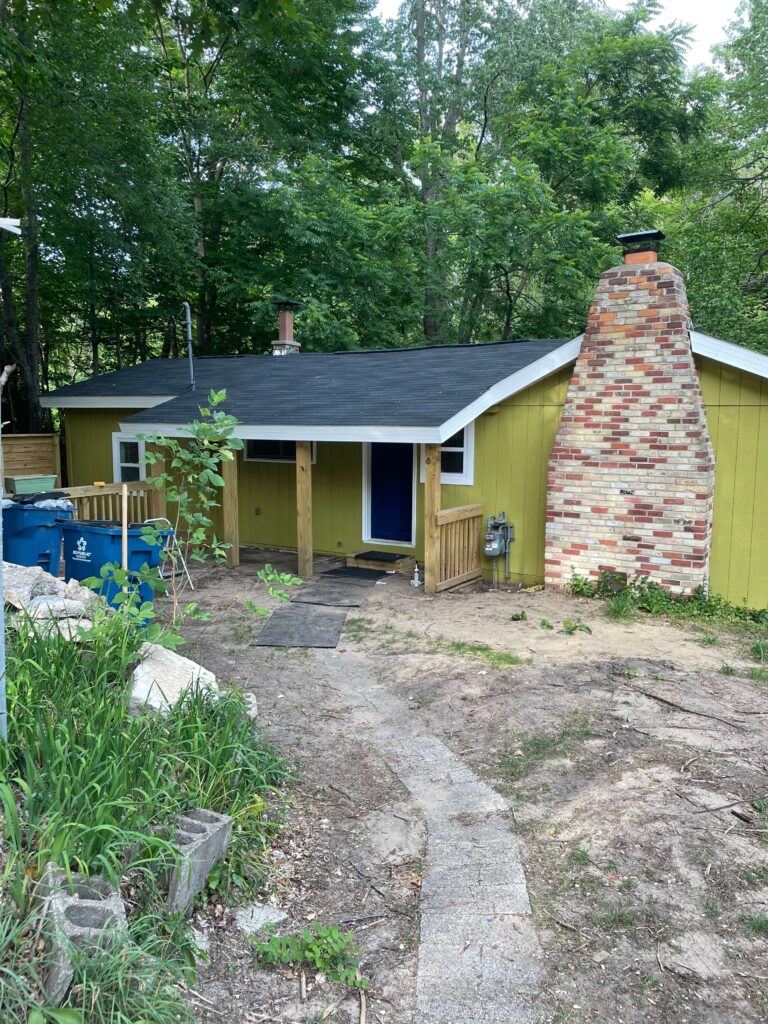
Lawn vs. Rocks: Weighing the Pros and Cons of Lawns and Hardscaping
To solve the flooding problem, we added a French Drain. We had two floods in the yard last Fall, so we needed to solve that problem first. A French drain was an easy solution. When I saw the rocks in the front yard for the drain, I liked them so much that it inspired the idea of adding a “hardscape over a lawn.”
Below is the French drain being added.

Pros of Adding Rocks:
- Low Maintenance: Rocks require virtually no watering, mowing, fertilizing, or weeding. Yay for less yard work! This is especially beneficial for lakefront properties where maintaining a lush lawn can be challenging due to sandy soil.
- Drought-Tolerant: Rocks are a sustainable and eco-friendly alternative in areas prone to drought or water restrictions.
- Design: Rocks come in a wide variety of colors, sizes, and textures, allowing for creative and unique landscaping designs.
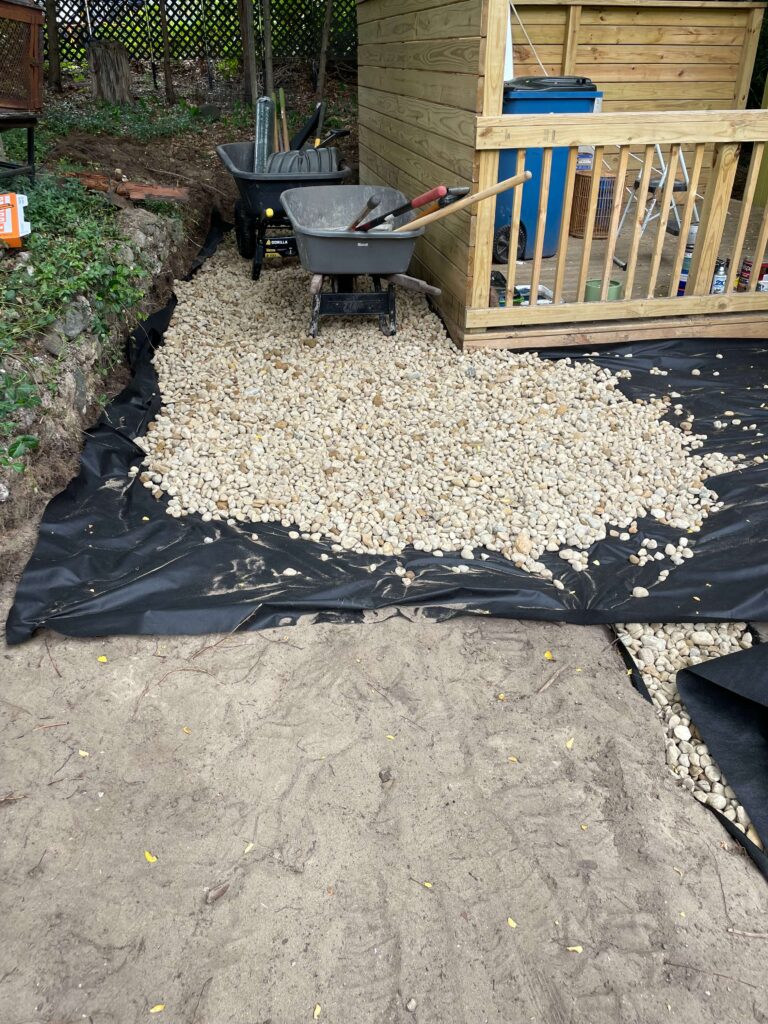
Cons of Rocks:
- Initial Cost: Installing a rock landscape can be expensive upfront, as it may require professional installation (we called in backup for this), the purchase of landscape fabric, and the rocks themselves.
- Heat Retention: Rocks can absorb and radiate heat, potentially making the area around them hotter, especially in direct sunlight.
- Limited Functionality: Unlike lawns, rocks don’t offer a soft surface for playing, relaxing, or walking barefoot. This isn’t a problem because a small area is left for yard games.
We chose to use large rocks over gravel. Mostly, I liked the look, and the coverage of the larger rocks was, in the end, more economical for us.
Creating Zones for Relaxation and Entertainment:
We laid out what we needed from the space in terms of zones. I wanted well-defined spaces. The deck for dining was always meant to be the focal point. (inside is a very tight eating space, so we need it to fit four comfortably outside). We also wanted a spot for a grill, a hammock, and a fire pit, as the back of the cottage has a creek (that goes to the lake), so there is no room for it back there. Plus, a stone wall of some sort will be installed to prevent cars from parking directly in front of the cottage.
Laying out the zones:
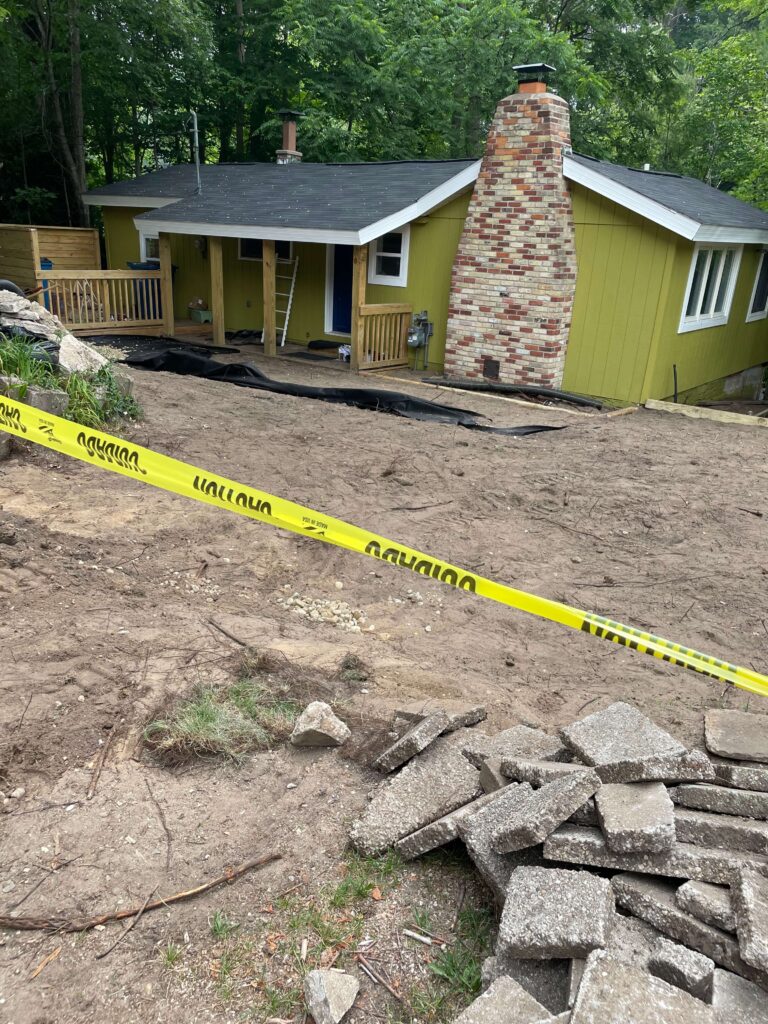
A small retaining wall from natural stone with a path is laid out.

Prepping for Plants-Soil Testing:
Next up: Prepping for plants!
You will definitely want to test your soil before choosing your plants for a few reasons:
- Plant Health and Success: Soil testing reveals your soil’s pH level and nutrient content. This information helps you select plants well-suited to your soil’s specific conditions. Matching plants to soil ensures they can access the proper nutrients and thrive, reducing the risk of plant stress, disease, and poor growth.
- Better Growth: If your soil lacks certain nutrients, you can correct it with the appropriate fertilizers or organic matter to create an ideal environment for plant growth. This leads to healthier plants and a more vibrant landscape.
- Cost Savings: Soil testing can save you money in the long run. By knowing what your soil needs, you can avoid over-fertilizing or applying unnecessary amendments, which can be costly and potentially harmful to the environment.
- Problem Prevention: Identifying potential issues like high acidity or alkalinity early on allows you to take corrective measures before planting. This proactive approach prevents future problems like nutrient deficiencies, root damage, or plant diseases.
It’s easy to test the soil yourself:
The easiest way to test the soil yourself is to buy a kit.
DIY pH Test:
- What it tests: Soil acidity or alkalinity (pH level). This is important because different plants thrive in different pH ranges.
- How to do it:
- Purchase a simple pH testing kit from a garden center or online.
- Follow the instructions to collect a soil sample and mix it with the provided solution.
- To determine your soil’s pH level, compare the solution’s color change to the chart included with the kit.
The Squeeze Test:
- What it tests: Soil texture (clay, silt, sand) and moisture retention. This helps you understand how well your soil drains and what types of plants it can support.
- How to do it:
- Moisten a handful of soil and squeeze it into a ball.
- Observe how the soil behaves:
- If it holds its shape and feels sticky, it’s likely clay soil.
- If it forms a ball but crumbles easily, it’s probably loamy soil (a good balance of clay, silt, and sand).
- If it falls apart and feels gritty, it’s likely sandy soil.
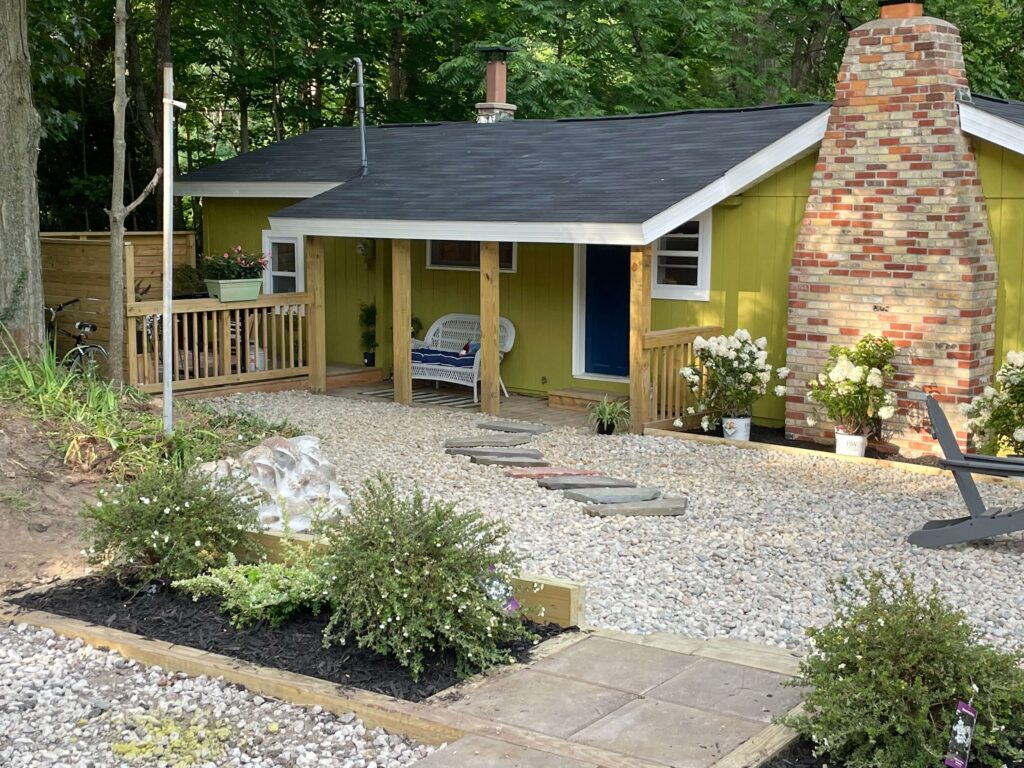
Choosing Plants for a Low-Maintenance Landscape
I am a fan of the ease…I wanted perennials that bloomed but were not too needy. My plant choices needed to tolerate full sun.
Here are some plant favorites:
- Hydrangea (Hydrangea spp.): Hydrangeas are beloved for their large, showy blooms in various colors (blue, pink, white, purple) and their ability to thrive in different light conditions. They are generally easy to care for and can tolerate a range of soil types. We planted three close to the house and then added a layer of mulch for some additional weed control.
- Spirea (Spiraea spp.): Spirea shrubs are known for their delicate blooms in Spring or summer, depending on the variety. They are low-maintenance, drought-tolerant, and attract pollinators. Look for varieties like ‘Gold Mound’ for vibrant foliage or ‘Neon Flash’ for bright pink flowers.
- Potentilla (Potentilla fruticosa): Also known as shrubby cinquefoil, potentilla is a hardy shrub that blooms for an extended period in summer. It’s available in various colors (yellow, orange, white, pink) and requires little pruning or maintenance. We added these along the small wall we built.
- Viburnum (Viburnum spp.): Viburnums offer a variety of options, from fragrant spring bloomers like Korean spice viburnum to those with colorful berries in Fall like Arrowwood viburnum. They are adaptable to different soil conditions and require minimal care. Woot Woot!
- Dwarf Lilac (Syringa meyeri ‘Palibin’): If you love the fragrance of lilacs but want a more compact option, dwarf lilacs are a great choice. They produce clusters of lavender blooms in Spring and require less space than traditional lilacs. I adore lilacs!
- Other plants that I love and would have worked with are Russian Sage, Purple coneflowers, some ornamental grasses, and deciduous trees.
Remember to consider your specific growing conditions (sunlight, soil type, hardiness zone) when selecting shrubs for your lake cottage. Choose varieties that are well-suited to your location for the best results.
Low-Maintenance Landscaping Ideas for a Lake Cottage
*This post contains affiliate links.
Okay, are you ready to see how it turned out?
Fire Pit Area:
We put a small metal fire pit on top of pavers buried in the rocks and added comfy Adirondack chairs for seating.

There was enough space for a hammock:

We now have plenty of room for 4 guests to comfortably dine on the 10 x 10 deck. I found most of the deck items at LOWES of all places! You can shop them here if you’d like.

And a cozy spot perfect for drinking morning coffee.
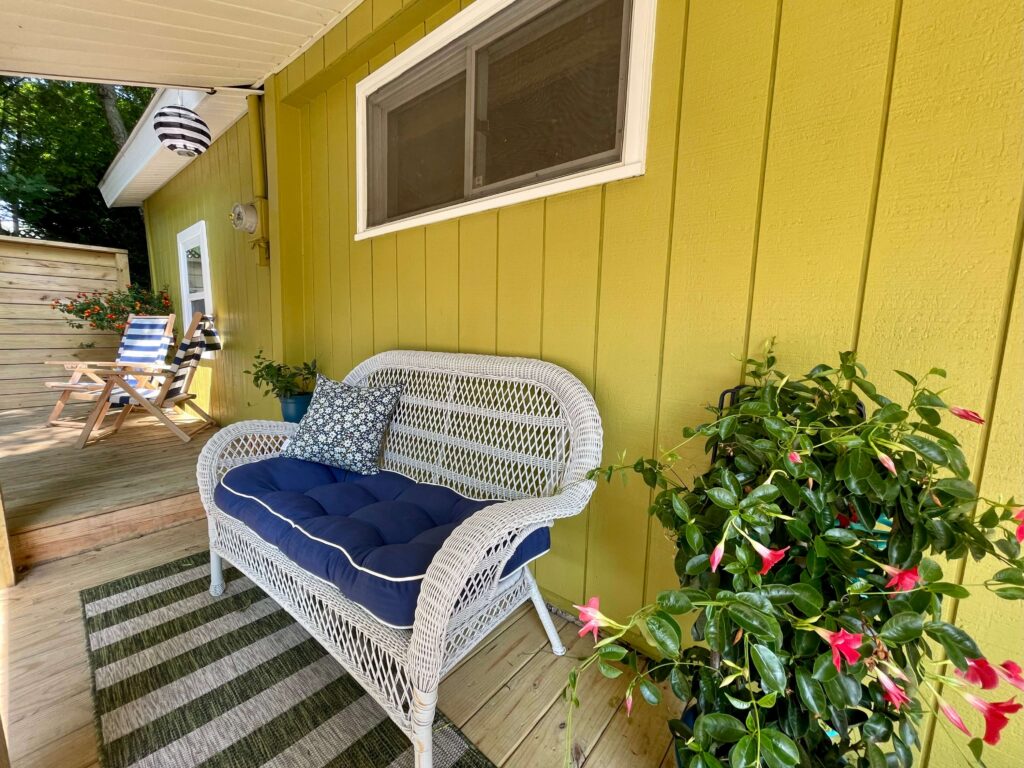
Where the lawn slopes off into the rocks, we planted myrtle, a fast-growing ground cover plant.
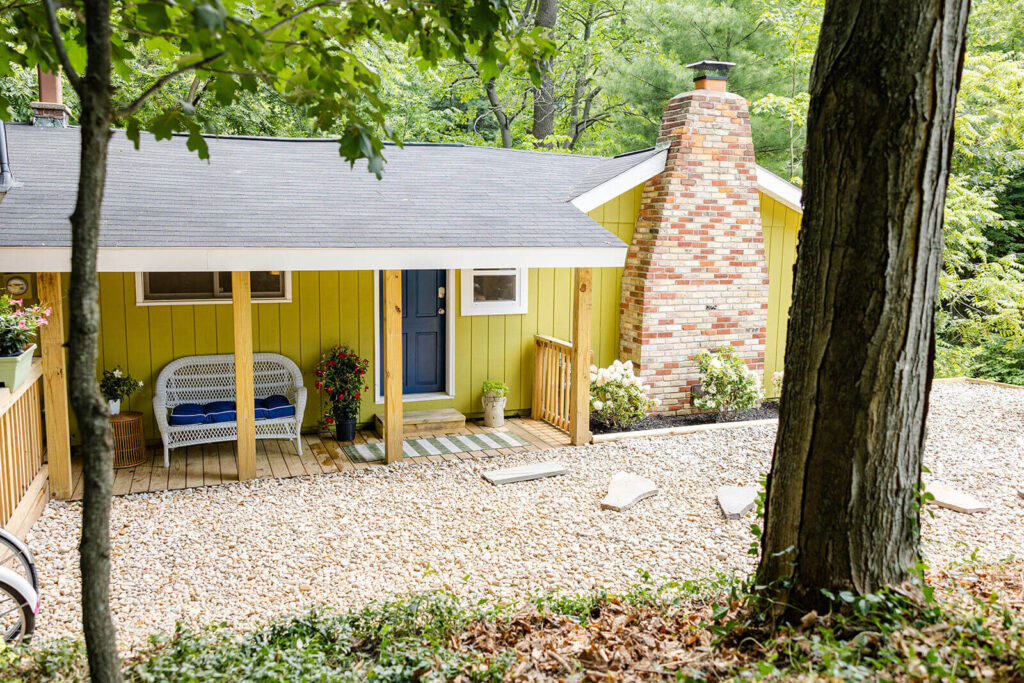
The front door is painted SW Salty Dog.

We still have plans to build a covered porch off the back of the house, but we love the front landscaping!
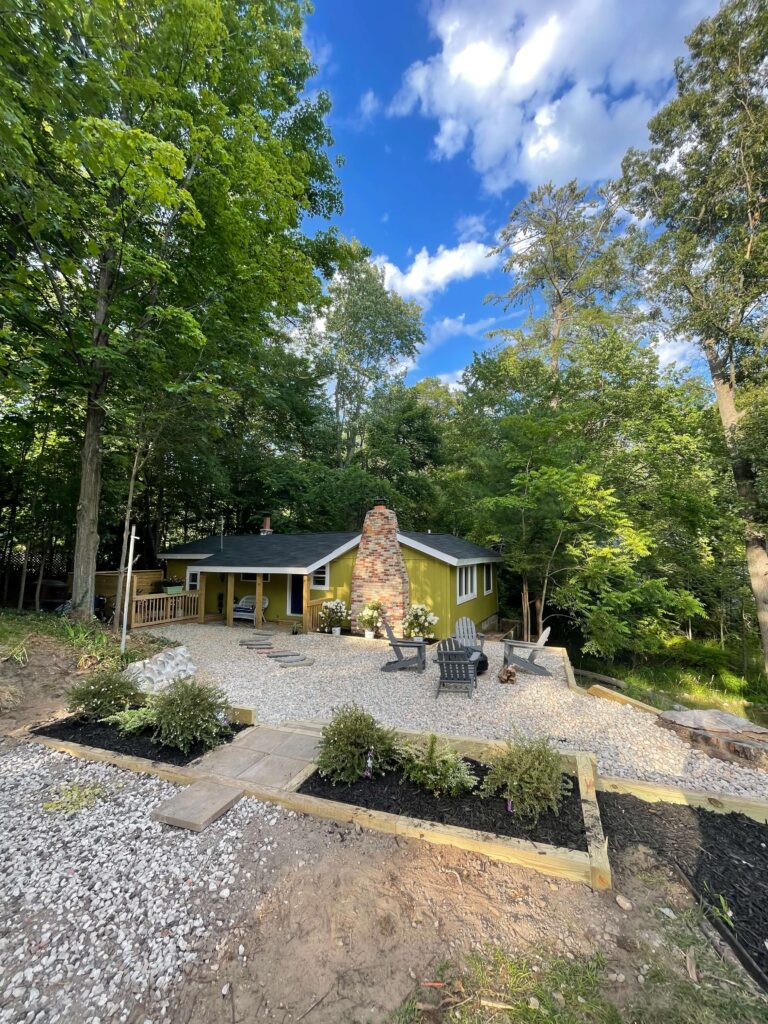
Our next project is to work on our outdoor living spaces at the lake house. We’ve been trying to figure out our landscaping plan for that space. Stay tuned for those details coming soon.
Until Next time,
-Libbie
You May Also Enjoy:
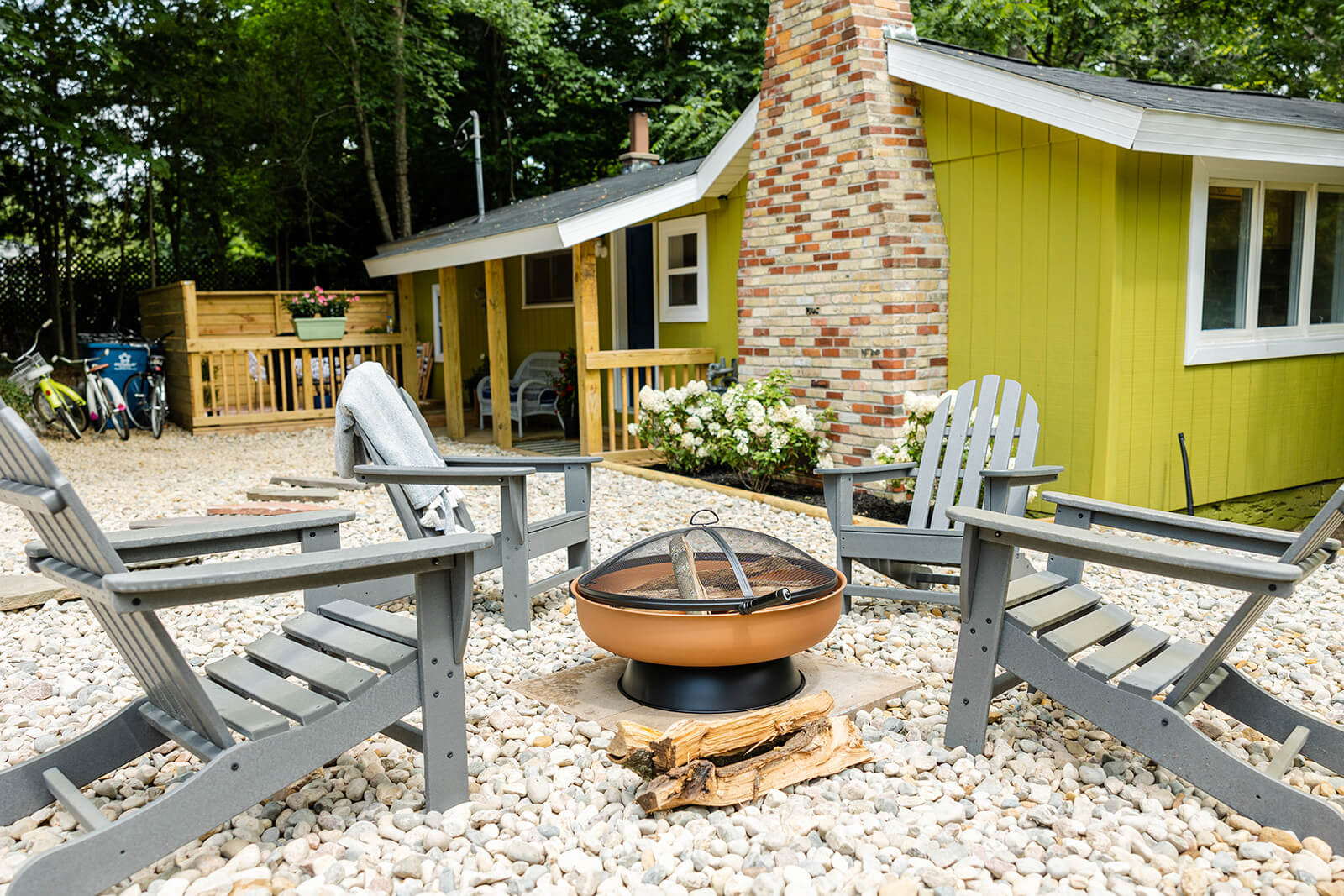


I have read your post, it’s very informative and helpful too for readers. Professional and efficient service from the outdoor lighting team, transforming our yard into a nighttime oasis.